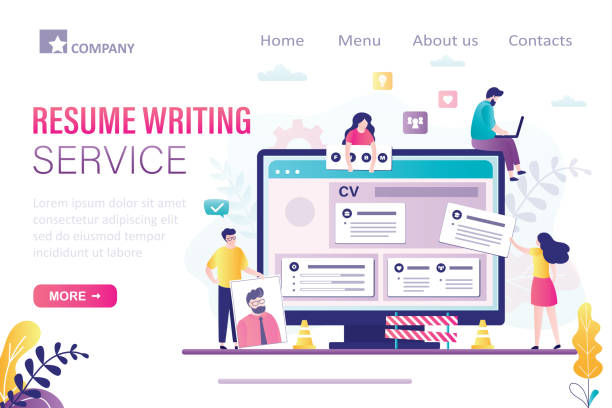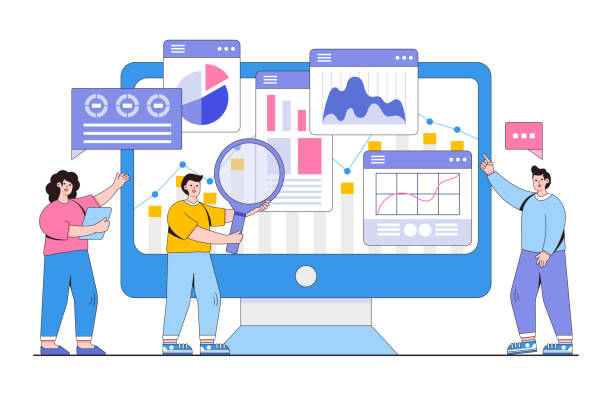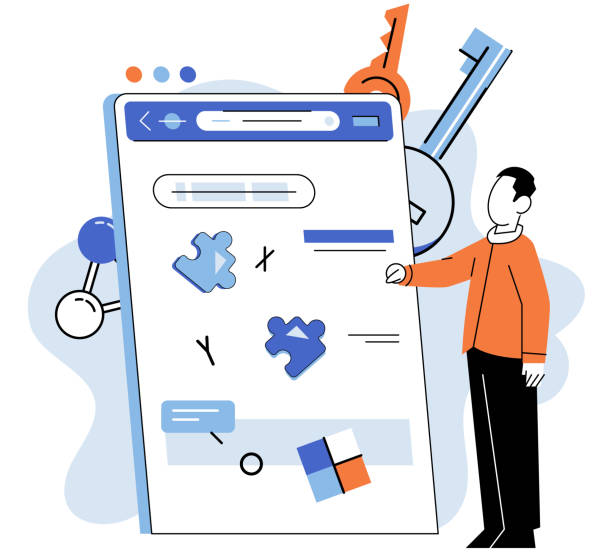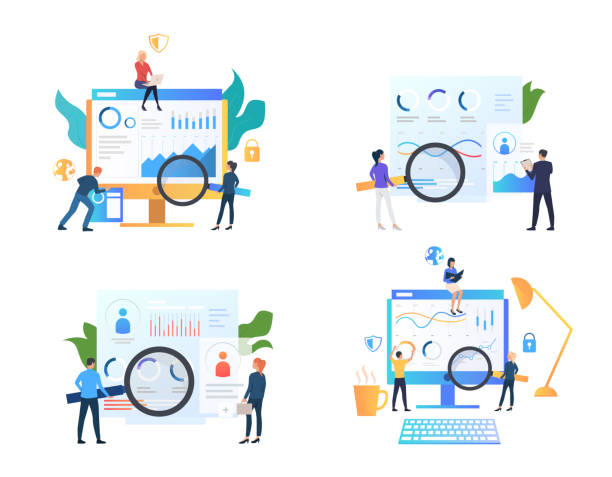Introduction to the Importance of Fast Website Design in Today’s World

In the current digital age, #website_speed is not just a competitive advantage, but a vital necessity.
User experience is heavily influenced by page load times, and every second of delay can mean losing potential visitors and customers.
Fast website design has increasingly become a top priority for businesses that want to succeed online.
This not only helps with search engine rankings but also increases conversion rates, reduces bounce rates, and improves overall user satisfaction.
Numerous studies have shown that users expect websites to load in less than a few seconds, and if this doesn’t happen, they quickly leave the site and go to competitors.
Therefore, investing in increasing website speed is a smart investment for the future of your business.
This approach is, in fact, an explanatory perspective on one of the most important aspects of web development.
To achieve fast website design, a deep understanding of the factors affecting performance and various optimizations at both front-end and back-end levels is required.
This guide will help you get acquainted with the basic principles and techniques and enable you to provide a website with optimal load time and an excellent user experience.
From optimizing images and CSS/JavaScript codes to choosing suitable hosting and using Content Delivery Networks (CDNs), every detail can affect your site’s overall speed.
The ultimate goal is to deliver a fast website that keeps users engaged and achieves your business objectives.
Furthermore, Google and other search engines place great importance on page load speed and consider it one of the key factors in their ranking algorithms.
This means that fast website design can directly impact your site’s SEO and its visibility in search results.
The faster your site is, the more likely users are to find and visit it.
This article is designed as a comprehensive resource for anyone looking to improve their website’s performance, helping you build a high-speed and efficient site with the necessary knowledge and tools.
This approach means providing an unparalleled user experience that will significantly contribute to the growth and success of your business online.
Are your e-commerce site visitors leaving before making a purchase? Worry no more! With Rasaweb’s professional e-commerce website design services, solve the problem of visitors not converting into customers forever!
✅ Significant increase in conversion rates and sales
✅ Unparalleled and engaging user experience
⚡ Contact us now for a free consultation!
Why is Website Speed Crucial for Online Success?

#The_impact_of_website_speed on user experience, #SEO, and #conversion_rates is not a topic that can be ignored.
In today’s world, where users quickly access information and competition for their attention is fierce, a slow website can quickly lead to lost opportunities.
An analysis shows that even a 100-millisecond delay in page loading can reduce conversion rates by up to 7%.
These figures clearly highlight the importance of fast website design for any online business.
Today’s users are impatient and expect websites to be immediately responsive; otherwise, they quickly turn to competitors who offer a better experience.
From an SEO perspective, Google has explicitly stated that site speed is a critical factor in search rankings.
This means that websites that load faster have a higher chance of achieving better positions in search results.
Website speed optimization not only helps your users but also signals to search engines that your website offers more value to visitors.
This creates a positive cycle: faster site, better ranking, more traffic, improved user experience, and ultimately, higher conversion rates.
Therefore, focusing on fast web loading is a comprehensive strategy for online growth.
This section, as an analytical content, elaborates on the deeper reasons behind this importance.
In addition to its direct impact on SEO and conversion rates, site speed also affects search engine crawlability.
Slow sites may be crawled less frequently by Googlebots, as their crawl budget is limited.
This means that new or updated pages may be indexed with a delay.
From a branding perspective, a high-speed site projects a professional and reliable image of your business, while a slow site can harm your credibility.
Consequently, the importance of fast website design extends beyond mere technicality and directly impacts the success of your marketing and business strategies.
Key Factors Affecting Website Speed and Their Optimization

#Numerous_factors influence #website_load_speed, and understanding them is the first step in fast website design.
These factors range from server selection and coding to multimedia content and client-side scripts.
Optimizing each of these areas can make a significant difference in the site’s final performance.
One of the most important factors is web hosting.
Choosing a reliable and high-speed host that has performed the necessary optimizations for its web server is the foundation of a fast website.
Server response time (Time To First Byte – TTFB) indicates how quickly the server responds to user requests, and the lower it is, the better.
Next, optimizing client-side resources becomes important.
High-volume images, uncompressed CSS and JavaScript files, and unnecessary code can severely reduce load speed.
Fast website design requires attention to details such as image compression, using next-generation image formats (like WebP), minification and Gzip compression of CSS and JS files, and eliminating render-blocking JavaScript.
Using caching also plays a vital role in reducing the number of server requests and increasing the speed of reloading pages for returning users.
This section, as specialized content, delves into a more detailed examination of these factors.
In this regard, we can provide a table to examine the main factors and their optimization solutions, which will help you better understand the process of website speed optimization:
| Affecting Factor | Description | Optimization Solution for Fast Website Design |
|---|---|---|
| Server Response Time (TTFB) | The amount of time it takes to receive the first byte from the server after a user request. | Choose a high-speed host, optimize server-side code, use server-side caching. |
| Image Size and Optimization | Large image sizes can slow down page loading. | Compress images, use WebP formats, Lazy Loading. |
| CSS and JavaScript Files | Uncompressed files and a high number of requests. | Minification, Gzip compression, file concatenation, asynchronous loading. |
| Browser Cache | Temporary storage of files in the user’s browser. | Properly configure cache headers for static resources. |
| Using CDN | Content delivery from servers closer to the user. | Use a Content Delivery Network for static content. |
In addition to the above, database optimization, reduction of HTTP requests, and the use of clean and optimized code also play a role in increasing website speed.
Each of these actions alone can bring improvements, but to achieve maximum speed, a comprehensive and coordinated approach is essential.
These principles are necessary for achieving a fast website and should be continuously monitored and optimized.
Key Tools for Measuring and Optimizing Website Speed

To properly implement fast website design, we must first understand the current state of website speed and which areas need improvement.
#Numerous_tools exist for #measuring and #analyzing website performance, providing precise information on load times, weaknesses, and optimization opportunities.
Google PageSpeed Insights is one of the most popular and important of these tools, not only evaluating your site’s speed but also offering practical suggestions for improvement.
This tool provides scores for site performance on desktop and mobile devices and displays a list of recommendations based on web optimization best practices.
GTmetrix is another tool that provides more in-depth information about your site’s loading, including full page load time, the number of HTTP requests, and performance scores based on PageSpeed and YSlow metrics.
This tool allows you to view a Waterfall Chart, which shows how long each resource (image, CSS, JS, etc.) takes to load and its impact on the overall load time.
Tools like Lighthouse (built into Chrome DevTools) also provide a comprehensive analysis of performance, accessibility, SEO, and PWA best practices, which are very useful for a high-speed site.
This section is designed as a practical guide for using these tools.
Regular use of these tools for monitoring site performance, after every change or update, is vital.
This helps you measure the impact of changes and quickly identify new issues.
Also, other tools like Pingdom Tools and WebPageTest exist, each offering unique features and perspectives.
By using this suite of tools, you can take effective steps for website speed optimization and ensure that your website always operates at maximum efficiency.
Fast website design is not possible without precise measurement, and these tools are the foundation of any optimization strategy.
Did you know that 85% of customers check your company’s website before any interaction?
With Rasaweb, build a corporate website worthy of your reputation.
✅ Increase credibility and customer trust
✅ Attract high-quality leads
⚡ Get free website design consultation
Front-End Optimization Techniques for Faster Page Loading

The #front-end of a website, meaning what the user directly sees and interacts with, plays a very important role in fast website design.
Optimizing this section involves a set of techniques aimed at reducing overall page size, optimizing HTTP requests, and improving rendering time.
One of the first steps is the compression and minification of CSS and JavaScript files.
This process involves removing unnecessary characters such as spaces, comments, and new lines from the code, which reduces file size and consequently speeds up their loading.
Also, Gzip compression should be enabled for all text resources (HTML, CSS, JS) to significantly reduce file sizes before they are sent to the user’s browser.
Image optimization is another crucial action in increasing website speed.
Images often constitute the largest portion of the total page size.
Using appropriate image formats (like WebP for modern images, JPEG for photos, and PNG for graphics with transparency) and compressing images without noticeable quality loss is essential.
Implementing Lazy Loading for images and videos also means that media content is only loaded when the user scrolls to it, which significantly reduces the initial page load time.
This topic, as an educational resource, introduces various techniques in detail.
Other vital techniques include font optimization, reducing the number of HTTP requests by combining CSS and JS files (if possible and logical), and utilizing browser caching.
Properly configuring cache headers (Cache-Control and Expires) allows browsers to store your site’s static resources in their cache for a specified period, resulting in much faster page loading for subsequent user visits.
Fast website design would not be complete without front-end optimization.
Furthermore, ensuring that CSS is loaded at the beginning of the HTML document (in the `head` section) and JavaScript at the end of the document (before the closing `body` tag) helps improve initial page rendering and provides a better user experience for fast web loading.
The Role of Back-End and Server Optimization in Increasing Site Efficiency

Alongside front-end optimizations, #back-end_optimization and #server_infrastructure are also of high importance for #fast and efficient_website_design.
A slow back-end can nullify even front-end optimizations.
Server Response Time (TTFB), mentioned earlier, is directly related to back-end optimization and server efficiency.
Choosing suitable and high-speed hosting with sufficient resources (CPU, RAM, and SSD disk space) is the first fundamental step.
Shared hosting services might be sufficient for small sites, but for high-traffic sites, using Virtual Private Servers (VPS), Dedicated Servers, or Cloud Hosting is recommended.
Database Optimization also plays a vital role in increasing website speed.
Ensuring that database queries are optimized and efficient, and that appropriate indexes are used for tables, can significantly reduce data retrieval time.
For Content Management Systems (CMS) like WordPress, optimizing the database through plugins or database management tools, and removing redundant and unused data, is essential.
Additionally, using server-side caching systems like Redis or Memcached can help store frequently used query results or dynamically generated content, reducing the need for reprocessing.
This section, with a specialized approach, delves into the more technical aspects of the topic.
Correct configuration of web servers (such as Apache or Nginx) for faster request handling, enabling Gzip compression and HTTP/2, and optimizing PHP settings (like PHP-FPM) are also important measures.
Fast website design requires coordination between the front-end and back-end.
An optimized back-end code consumes fewer server resources and, consequently, can respond to more requests in less time.
Regular monitoring of server performance and using log analysis tools to identify bottlenecks can also significantly contribute to maintaining a fast website.
Using Web Application Firewalls (WAF) and protection against DDoS attacks also helps maintain site stability and speed against threats.
Using Content Delivery Network (CDN) to Improve Global Site Speed

One of the most powerful strategies for fast website design and delivering content to users worldwide at maximum speed is the use of a Content Delivery Network (CDN).
#CDN is a system consisting of geographically distributed servers that cache your website’s static content (such as images, CSS files, JavaScript, videos, and fonts) and deliver it from the server closest to the user.
This approach significantly reduces the physical distance between the user and the content server, consequently drastically improving latency and page load time.
For example, if your website’s main server is in Iran and a user from Europe accesses it, without a CDN, the request must travel all the way to Iran, and the response must return.
But with a CDN, cached content is delivered to the user from a server in Europe (e.g., Germany or France), which minimizes this distance and time.
This not only increases speed but also reduces the load on your main server and improves site stability during high traffic.
CDNs also offer security features such as protection against DDoS attacks, which contribute to your site’s health and performance.
This section, as explanatory content, clearly articulates the benefits of using a CDN for fast web loading.
To better understand the difference, we can look at the table below:
| Feature | Without CDN | With CDN (Fast Website Design) |
|---|---|---|
| Load time for remote users | High (due to physical distance to the main server) | Low (content is delivered from the closest server) |
| Load on main server | High (all requests are processed by the main server) | Low (CDN manages many static content requests) |
| Resilience to high traffic | Vulnerable (main server may be overloaded and slow down) | High (traffic is distributed among CDN servers) |
| Security | Limited to main server protection | Increased (provides DDoS and WAF services) |
| User experience | Variable and potentially slow | Improved and more consistent globally |
Various CDN services are available, including Cloudflare, Akamai, Amazon CloudFront, and Google Cloud CDN, each with its own features and pricing.
Choosing the right CDN depends on your website’s needs and budget.
Implementing a CDN is a crucial step towards increasing website speed and providing a flawless experience for users anywhere in the world.
Therefore, in a high-speed website strategy, using a CDN is an indispensable element.
Responsive Design and Mobile Speed in the Mobile-First Era

In today’s world, where a significant portion of web traffic comes from mobile devices, #responsive_design and #mobile_speed have become fundamental principles in #fast_website_design.
Google also adopted the “Mobile-First Indexing” approach years ago, meaning it uses the mobile version of websites for ranking.
A website might be fast on desktop, but if it performs slowly on mobile, it not only provides a poor user experience but also severely harms its SEO ranking.
Therefore, ensuring that your website is not only responsive but also loads quickly on mobile devices is crucial.
Responsive Design means that your website’s layout and content automatically adjust to the screen size of the user’s device.
This not only contributes to the site’s aesthetic appeal but also enhances usability by eliminating the need for zooming or horizontal scrolling.
However, being merely responsive is not enough; attention must also be paid to optimizing speed for mobile.
This includes using images with appropriate sizes and resolutions for mobile, reducing render-blocking JavaScript, prioritizing the loading of above-the-fold content, and using technologies like AMP (Accelerated Mobile Pages) if necessary.
This section, as analytical content, emphasizes the importance of distinguishing mobile speed from desktop speed.
Google’s Core Web Vitals metrics (LCP, FID, CLS), which directly impact user experience and site speed, are evaluated separately for mobile and desktop.
Therefore, for fast website design in the mobile era, developers must specifically focus on optimizing performance on mobile devices.
Using tools like Google PageSpeed Insights and Lighthouse, with a focus on mobile reports, can help identify weaknesses and provide effective solutions.
The ultimate goal is to provide a fast website that offers a consistent and optimized user experience on any device, contributing to business success in the mobile-first world.
Did you know that customers’ first impression of your company is your website? With a powerful corporate website from Rasaweb, multiply your business’s credibility!
✅ Custom and eye-catching design tailored to your brand
✅ Improved user experience and increased customer acquisition
⚡ Get a free consultation!
Common Mistakes in Website Speed Optimization and How to Avoid Them

In the path of #website_speed_optimization and #fast_website_design, making #common_mistakes is inevitable.
However, recognizing and avoiding these errors can save a lot of time and resources and prevent serious problems in site performance.
One of the biggest mistakes is neglecting the importance of hosting and not investing enough in a quality server.
Even if your site’s coding is excellent, slow or inadequate hosting can render all your efforts fruitless.
Are you using cheap shared hosting for a high-traffic website? This itself is a big mistake!
Another common mistake is the lack of image optimization and using images with unnecessarily large sizes and dimensions.
Many websites spend hours optimizing code but forget that images can be the biggest factor in slow loading.
Not using browser cache or incorrect settings can also force the browser to reload all resources on every return visit, which severely degrades user experience.
Furthermore, excessive loading of web fonts, unnecessary JavaScript scripts, or heavy plugins (especially in Content Management Systems like WordPress) can lead to significant site slowdowns.
This section, with guidance and thought-provoking content, makes you ponder.
Do you regularly monitor your site’s speed and review reports from tools like PageSpeed Insights? Ignoring these reports and their recommendations is another common mistake.
Also, not using a CDN for sites with global audiences, due to increased latency, can severely impact user experience.
To achieve fast website design, a comprehensive and continuous approach is needed, and optimizing only one aspect of the site should be avoided.
In summary, to avoid these mistakes, it is essential to consider a comprehensive strategy for increasing website speed, use the correct tools, and continuously monitor your site’s performance.
Successful Case Studies in Fast Website Design

To gain a deeper understanding of the potential of #fast_website_design, examining real #case_studies can be highly illuminating.
#Many_businesses, by focusing on optimizing their site speed, have achieved brilliant results in increasing user engagement, improving conversion rates, and enhancing their search engine rankings.
For example, one of the e-commerce giants, AliExpress, by reducing page load time by 100 milliseconds, managed to increase its conversion rate by 1.04%.
This demonstrates that even small improvements in load speed can have significant financial impacts.
These examples prove that fast website design is not an expense but a profitable investment.
Another example of success in website speed optimization could be related to a news platform.
The New York Times, through extensive optimizations in image and video loading, and also by using a CDN, managed to reduce its article load time to an average of under 2 seconds.
This led to a significant increase in the number of pages viewed per user and a decrease in bounce rate, indicating greater user satisfaction with the reading experience on a high-speed site.
These cases clearly illustrate how fast web loading can directly impact business performance and customer satisfaction.
This section, as news content, provides empirical evidence and can also serve as entertaining material, as it offers tangible and inspiring results.
On the other hand, Google’s research shows that if a page takes more than 3 seconds to load on mobile, 53% of users will abandon it.
Many companies have managed to solve this challenge by focusing on optimizing Core Web Vitals and implementing advanced techniques such as preloading and prefetching resources.
These success stories emphasize that fast website design is not just a technical goal but an essential business strategy that can bring sustainable competitive advantages.
Frequently Asked Questions
| Question | Answer |
|---|---|
| What is fast website design? | The process of building a website that loads quickly and provides a smooth user experience. |
| Why is website speed important? | Improved user experience, reduced bounce rate, increased conversion rates, and better search engine ranking (SEO). |
| What factors affect website speed? | Image size, number of HTTP requests, code optimization (HTML, CSS, JS), host speed, and browser caching. |
| How can website speed be improved? | Optimizing images, compressing files, using caching, choosing suitable hosting, and reducing unnecessary plugins. |
| How do images affect website speed? | High-volume images or inappropriate formats can significantly increase page load time. |
| What is the role of JavaScript and CSS in website speed? | Unoptimized code, large file sizes, or render-blocking execution can reduce page rendering speed. |
| How much does hosting affect website speed? | The speed and quality of the hosting server directly impact website responsiveness and initial load speed. |
| What tools are available to check website speed? | Google PageSpeed Insights, GTmetrix, Pingdom Tools are common tools. |
| What are the benefits of a fast website? | Greater user satisfaction, reduced bounce rate, increased time on site, and improved ranking in Google results (SEO). |
| What are common mistakes that slow down a website? | Using unoptimized images, bulky and unorganized code, excessive use of plugins, and not using caching. |
And other services of Rasaweb Advertising Agency in the field of advertising
Smart Digital Advertising: A novel service to increase website traffic through the use of real data.
Smart Digital Branding: A dedicated service for sales growth based on marketing automation.
Smart UI/UX: A fast and efficient solution for customer acquisition, focusing on attractive user interface design.
Smart Digital Advertising: A creative platform for improving website traffic with intelligent data analysis.
Smart Google Ads: A creative platform for improving sales with attractive user interface design.
And over hundreds of other services in the field of internet advertising, advertising consultation, and organizational solutions
Internet Advertising | Advertising Strategy | Advertorial
Sources
Website Speed Optimization
User Experience Design (UX)
Mobile-Friendly Website Design Guide
Increasing Website Efficiency
In the fast-paced digital world, your powerful online presence is the key to success. Rasaweb Afarin, with its expertise in digital marketing, from professional corporate website design to search engine optimization, will be the bridge connecting your business with your audience.
📍 Tehran, Mirdamad Street, next to Bank Markazi, Southern Kazerun Alley, Ramin Alley, No. 6



